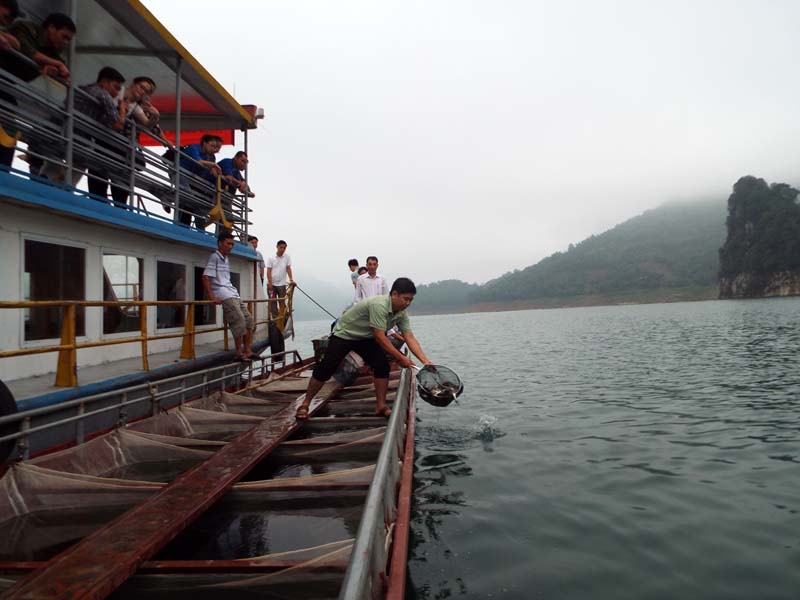
(HBO) - Hoa Binh lake has a total water surface area of 16,800 hectares, including 8,900 hectares in Hoa Binh province stretching 19 communes of four districts - Da Bac, Mai Chau, Cao Phong, and Tan Lac - and Hoa Binh city. This area boasts a great potential for the development of the fishery sector.
Hoa Binh lake is
considered a precious treasure of aquatic resources in the Northwest region.
The natural aquatic resources and distribution of local natural aquatic species
in the lake are relatively abundant.
As many as 24 natural spawning grounds of four fish groups have been identified
in the area of Hoa Binh lake, including the groups of floating-egg spawners;
sticky and semi-sticky egg spawners; laying-eggs-in-cave spawners; and those
incubate eggs in their mouth.
The fish system in Hoa Binh province’s Da
River includes 94 species and subspecies belonging to 712 varieties and 21
families in eight orders. Of them, there are 88 indigenous fish species. There
are many rare fish species in the lake such as: Chien (Bagarius yarrelli); Bong (Spinibarbus denticulatus); Lang (Hemibagrus); Anh Vu (Semilabeo
notabilis) and other rare aquatic species.

From 2012 onwards, Hoa Binh province has maintained
the release of young fish into Hoa Binh lake to increase its aquatic resources.
Attention
has also paid to reproducing fisheries resources. Hoa Binh province has
maintained campaigns to raise public awareness of protecting fisheries
resources and releasing young fish in the lake for many years.
According to the provincial Department of Fisheries, in recent years, the fishing
activity and fish farming in the Hoa Binh lake helps reduce poverty,
importantly contributing to local economic development.
However, the over-exploitation of aquatic
products and violations of relevant regulations have caused a decline in
aquatic resources, and put many rare fish species in danger of extinction.
The local authorities are focusing on researching and transferring the application
of raising aquatic species with high economic value, disease resistance and adaption
to natural conditions of each area, thus promoting clean and sustainable
aquaculture.
Hoa Binh is also paying heed to creating
new jobs for local people around the lake such as raising fish in cages and,
enhancing the processing of aquatic products, and developing other trades in
order to reduce the over-fishing. Meanwhile, models for managing and protecting
fishery resources have been also set up with the involvement of local
communities./.
The emulation movement "Hoa Binh joining hands to build new-style rural areas” has been widely spreading, becoming a driving force that motivates the localities to renew rural landscapes and improve the material and spiritual lives of the residents. In this movement, the people play a central role-both as the main implementers and direct beneficiaries of its outcomes.
In response to the global digital revolution, Hoa Binh Newspaper is transforming itself into a modern and multi-platform media hub, blending cutting-edge technology with a restructured newsroom and a new generation of tech-savvy journalists.
Hoa Binh province’s Association of the Elderly recently held a conference to review the project on expanding the inter-generation self-help club model until 2025.
In a move to implement Resolution No. 57-NQ/TW, issued on December 22, 2024 by the Politburo, which targets breakthroughs in science-technology development, innovation, and digital transformation, the Hoa Binh provincial Department of Health has issued a plan to roll out the "Digital Literacy for All” campaign within the local health sector.
An Nghia Commune (Lạc Sơn District) is one of the communes that achieved the tha standard of the national new rural area in 2018. Entering a new development phase, the commune is now trying to meet the criteria for the advanced new rural development. With the strong political will and the public consensus, the commune is gradually overcoming the challenges to reach this goal, aiming for the sustainable development.



